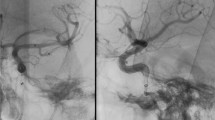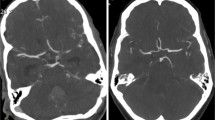Abstract
Introduction
Contrast-enhanced cone-beam computed tomography (CBCT) has been introduced and accepted as a useful technique to evaluate delicate vascular anatomy and neurovascular stents. Current protocol for CBCT requires quantitative dilution of contrast medium to obtain adequate quality images. Here, we introduce simple methods to obtain contrast-enhanced CBCT without quantitative contrast dilution.
Methods
A simple experiment was performed to estimate the change in flow rate in the internal carotid artery during the procedure. Transcranial doppler (TCD) was used to evaluate the velocity change before and after catheterization and fluid infusion. In addition, 0.3 cm3/s (n = 3) and 0.2 cm3/s (n = 7) contrast infusions were injected and followed by saline flushes using a 300 mmHg pressure bag to evaluate neurovascular stent and host arteries.
Results
Flow velocities changed −15 ± 6.8 % and +17 ± 5.5 % from baseline during catheterization and guiding catheter flushing with a 300 mmHg pressure bag, respectively. Evaluation of the stents and vascular structure was feasible using this technique in all patients. Quality assessment showed that the 0.2 cm3/s contrast infusion protocol was better for evaluating the stent and host artery.
Conclusion
Contrast-enhanced CBCT can be performed without quantitative contrast dilution. Adequate contrast dilution can be achieved with a small saline flush and normal blood flow.




Similar content being viewed by others
Abbreviations
- CBCT:
-
Cone-beam CT
- CM:
-
Contrast medium
- mFV:
-
Mean flow velocity
- TCD:
-
Transcranial Doppler
References
Clarencon F, Piotin M, Pistocchi S, Babic D, Blanc R (2012) Evaluation of stent visibility by flat panel detector CT in patients treated for intracranial aneurysms. Neuroradiology 54:1121–1125
Hosokawa S, Kawai N, Sato M, Minamiguchi H, Nakai M, Nishioku T, Sonomura T, Matsumoto H, Masuo O, Itakura T (2012) Optimal contrast material concentration for distinguishing among carotid artery lumen, carotid stent, and neck in cone-beam computed tomography during carotid angiography: basic and clinical studies. Jpn J Radiol 30:358–364
Patel NV, Gounis MJ, Wakhloo AK, Noordhoek N, Blijd J, Babic D, Takhtani D, Lee SK, Norbash A (2011) Contrast-enhanced angiographic cone-beam CT of cerebrovascular stents: experimental optimization and clinical application. AJNR Am J Neuroradiol 32:137–144
Stidd DA, Theessen H, Deng Y, Li Y, Scholz B, Rohkohl C, Jhaveri MD, Moftakhar R, Chen M, Lopes DK (2014) Evaluation of a metal artifacts reduction algorithm applied to postinterventional flat panel detector CT imaging. AJNR Am J Neuroradiol 35:2164–2169
Caroff J, Mihalea C, Neki H, Ruijters D, Ikka L, Benachour N, Moret J, Spelle L (2014) Role of C-arm VasoCT in the use of endovascular WEB flow disruption in intracranial aneurysm treatment. AJNR Am J Neuroradiol 35:1353–1357
ElSankari S, Baledent O, van Pesch V, Sindic C, de Broqueville Q, Duprez T (2013) Concomitant analysis of arterial, venous, and CSF flows using phase-contrast MRI: a quantitative comparison between MS patients and healthy controls. J Cereb Blood Flow Metab 33:1314–1321
Radvany MG, Ehtiati T, Huang J, Mahesh M, Gailloud P (2012) Aortic arch injection with C-arm cone beam CT for radiosurgery treatment planning of cerebral arteriovenous malformations: technical note. J Neurointerv Surg 4:e28
Pereira VM, Ouared R, Brina O, Bonnefous O, Satwiaski J, Aerts H, Ruijters D, van Nijnatten F, Perren F, Bijlenga P, Schaller K, Lovblad KO (2014) Quantification of internal carotid artery flow with digital subtraction angiography: validation of an optical flow approach with Doppler ultrasound. AJNR Am J Neuroradiol 35:156–163
Scheel P, Ruge C, Petruch UR, Schoning M (2000) Color duplex measurement of cerebral blood flow volume in healthy adults. Stroke 31:147–150
Dahl A, Russell D, Rootwelt K, Nyberg-Hansen R, Kerty E (1995) Cerebral vasoreactivity assessed with transcranial Doppler and regional cerebral blood flow measurements. Dose, serum concentration, and time course of the response to acetazolamide. Stroke 26:2302–2306
Krejza J, Mariak Z, Babikian VL (2001) Importance of angle correction in the measurement of blood flow velocity with transcranial Doppler sonography. AJNR Am J Neuroradiol 22:1743–1747
Manno EM, Gress DR, Schwamm LH, Diringer MN, Ogilvy CS (1998) Effects of induced hypertension on transcranial Doppler ultrasound velocities in patients after subarachnoid hemorrhage. Stroke 29:422–428
Uematsu S, Yang A, Preziosi TJ, Kouba R, Toung TJ (1983) Measurement of carotid blood flow in man and its clinical application. Stroke 14:256–266
Ethical standards and patient consent
We declare that all human and animal studies have been approved by the local Ethics Committee and have therefore been performed in accordance with the ethical standards laid down in the 1964 Declaration of Helsinki and its later amendments. We declare that all patients gave informed consent prior to inclusion in this study.
Conflict of interest
We declare that we have no conflict of interest.
Author information
Authors and Affiliations
Corresponding author
Rights and permissions
About this article
Cite this article
Jo, K.I., Kim, S.R., Choi, J.H. et al. Contrast-enhanced angiographic cone-beam computed tomography without pre-diluted contrast medium. Neuroradiology 57, 1121–1126 (2015). https://doi.org/10.1007/s00234-015-1570-0
Received:
Accepted:
Published:
Issue Date:
DOI: https://doi.org/10.1007/s00234-015-1570-0




